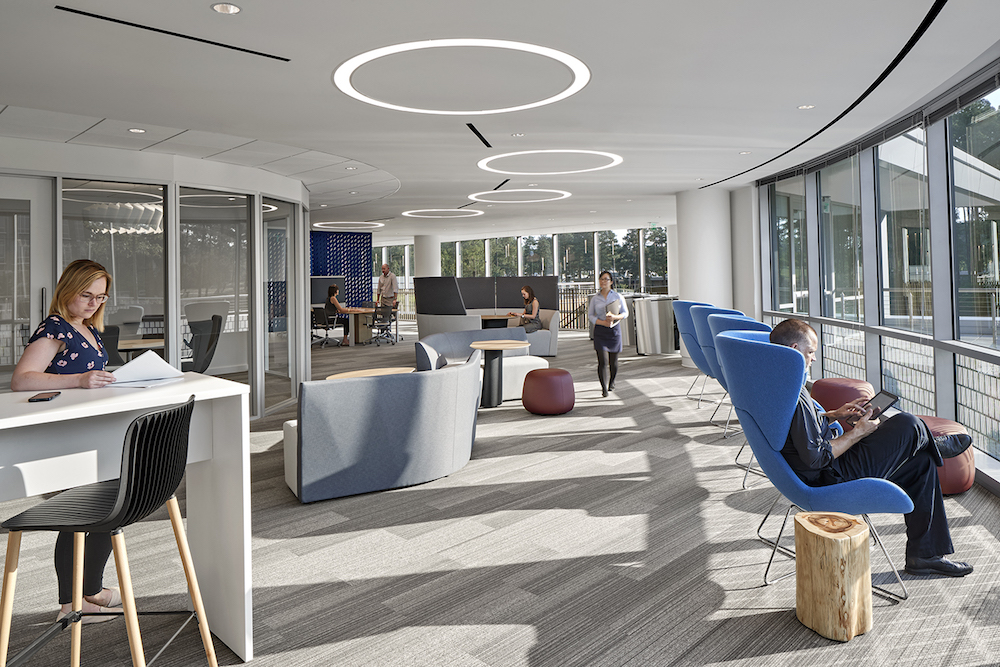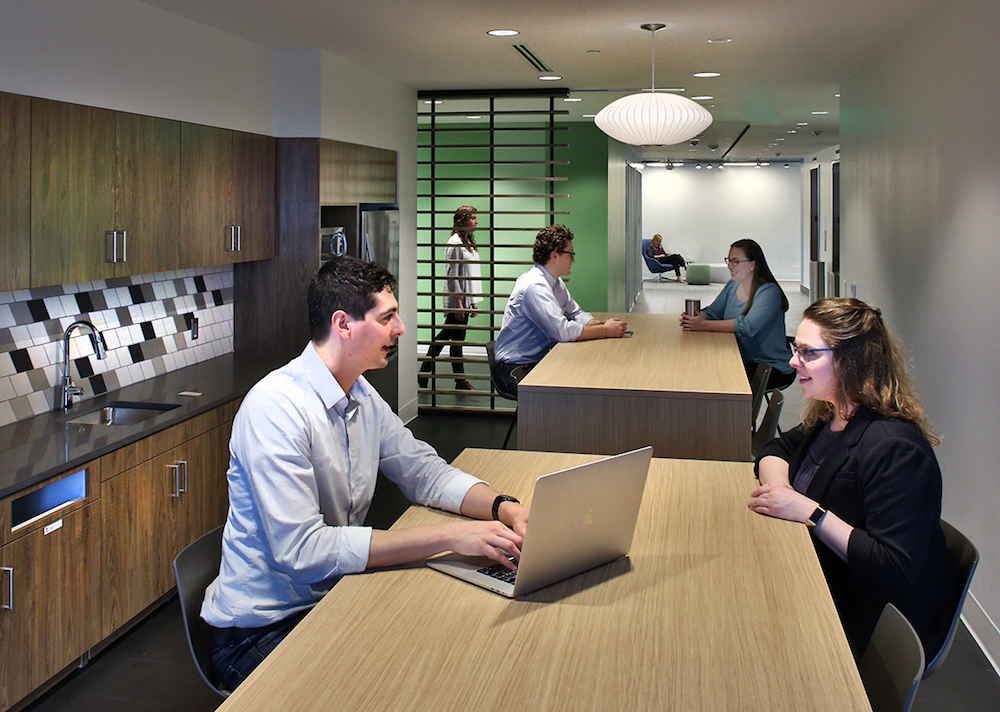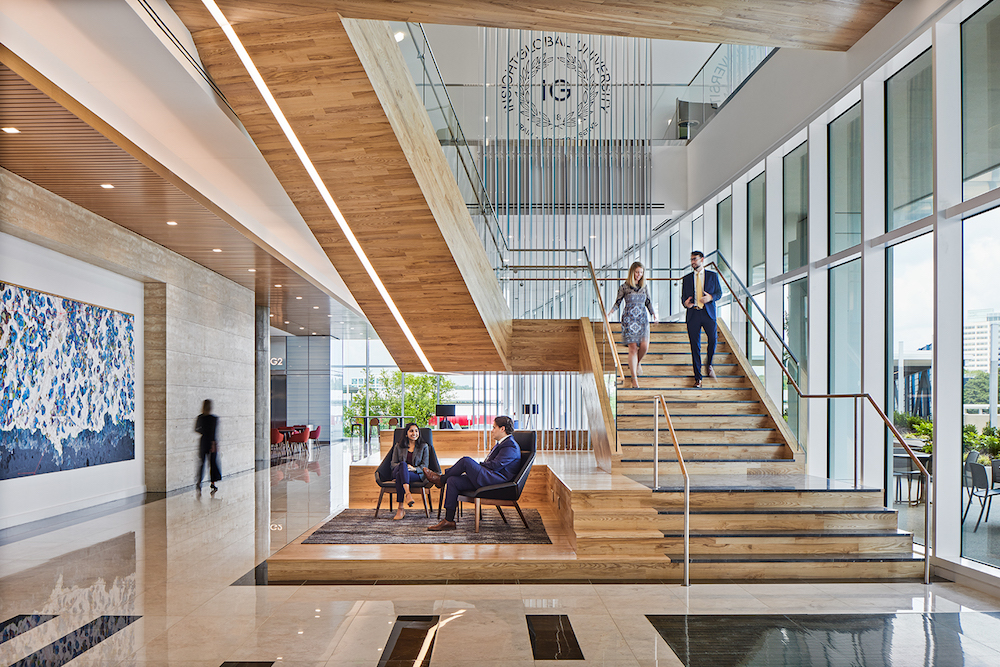Jeffrey Paine and Bethany Ratcliff explore how to develop future workplaces that meet client needs and sustain office culture.

Today everyone is more aware of how essential health and safety measures are to protecting our own and our employees’ wellbeing. After many months of working remotely, companies and their staff aren’t ready to say “goodbye” to the collaboration and learning that comes when we work side-by-side. The office is where an organization strengthens its culture, purpose, collective energy, talent, and innovation. Many companies implemented temporary measures, but many of our adaptations for the pandemic will endure. The best way forward? Develop office design and workplace policies that integrate the best of both work environments while meeting client needs and sustaining office culture.
MESSAGING MOMENT
Communication is crucial to keeping staff engaged with one another and clients. Whatever path an organization takes establishing a post-pandemic environment, messaging—in reality, over-communicating—all planning, decision-making and decision rationale is vital. This builds a culture of trust between management and staff. Equitable practices and compassion are part of these communications, as is sitting down one-on-one with staff to discuss challenges they may face in returning. As a business, clients make our work and culture possible, so communicating also involves ensuring employees understand the need to balance their concerns with the work we do for others.

PHASING
Phasing is critical in transitioning from working fully remote to working in the office, and flexibility must at the core of every phasing strategy. At first, we had everyone move out of their desks—no one had a permanent spot. Early on, some project teams had to work in the office, which allowed them to distance safely and follow the firm’s sanitation protocols. The next phase allowed people to meet in the office with distancing and masks, but they left when the meeting ended. Then, we assigned everyone a desk, placing teams near one another, and allowed staff to coordinate within their project teams when, or if, they needed to come into the office. Temporary, easy-to-remove partitions were put in place.
Now, we have invited everyone back but are cautious about large in-person meetings and gatherings. Regularly monitoring CDC guidelines is a new normal in addressing both employee needs and our clients’ expectations.
HYBRID OFFICE
The future workplace is driven by flexibility and balance—both for employees and to meet commitments to clients and customers. Seamless interaction is essential no matter where people work. We’re replicating the technology used by our staff in their homes, so everyone has the technology and hardware to work remotely or in the office. Despite the capital costs, this redundancy allows us to pivot easily between working remote and in-office, whether to better serve a client or protect employee health.
The future workplace is driven by flexibility and balance
Many people found they experienced lower stress levels and greater efficiency working at home. One question is, how do we balance a return to our collaborative culture while staying competitive with what employees want? One way is to bring the comfort and options of home to the office. By providing options—standing desks, couches and seating pods, different sized meeting rooms, and collaboration areas—for how people work, companies can bring the characteristics of working from home into the office.

Partitions and plastic shields support a sanitary environment, but often interfere with collaboration and teamwork. Desk and meeting pods allow two to four people to meet with distancing, encouraging both collaboration and safety. Adding more conferences rooms sized for small teams to meet safely provides space that can will have future value in fostering team collaboration and focused work sessions without taking up larger conference spaces. Connecting stairs between floors encourage movement, decrease elevator use, and build community.
Working and meeting outdoors are safe alternatives to indoor spaces when weather permits
Distanced desks, alternating desks and workspaces, and orienting employees to face away from each other are all strategies that encourage healthy behaviors and aid employees’ comfort with returning. Working and meeting outdoors are safe alternatives to indoor spaces when weather permits. Many companies are establishing outdoor options for employees to be safe and feel comfortable.
Those of us setting policies and procedures should remember what we liked about working from home. The best of both worlds means having the right space to collaborate and be a part of a culture, while also having the ability to work remotely when needed. Whatever works best for a company will depend on their culture and workflow, but being together is typically best for professional growth, collegiality, and company culture.
TECHNOLOGY
Technology provides some answers to designing a safe workplace today. New and not-so new anti-microbial materials and finishes aid in reducing the transmission of viruses and bacteria. These “smart” materials are easy to maintain, resist mold, and promote good indoor air quality. Hands-free or “touchless” technology for opening doors, hand washing, toilet flushing, and water dispensing are increasing in use. New touchless systems allow visitors to use a scanned QR code at an entry kiosk and gain access to an elevator and doorway. Hand sanitizer stations will be readily available. Multiple cameras in conference rooms allow everyone—in-office and virtual team members—to be seen. With increased time on-screen, new eyeglass lenses block blue light to reduce eye strain and damage.
Features requiring greater investment, such as ventilation through operable windows, improved air filtration, HVAC systems that bring in more outdoor air, and destination dispatch elevators will take time to adopt. More expensive technology takes longer to become commonplace. However, much like LEED adoption, new technologies will become more desirable.

OPEN ADVICE
Younger staff have adapted well to staying connected virtually even when working fully remote. Older managers and employees, who often struggle with establishing strong connections while working virtually, need to learn from younger staff about how technology helps us maintain culture and productivity. One size does not fit all, and business owners are contemplating how to meet the needs of all generations while not losing their company’s core values.
One size does not fit all
By focusing on communications, developing flexible systems and policies, and building trust and respect, we are finding our path through the uncertainty of the virus and the business climate. In bringing people back to the office, phase the process gradually. Along the way, communicate clearly and explain the decisions being made thoroughly to employees, with room for dialogue and feedback.
Architects and designers are central to our coming back together. We must prepare for future viruses by creating even safer living and working environments. Technology will play a role, but safety has two facets: being safe and feeling safe. Technology can help, but architects and designers provide the essential insight to help clients ensure employees are safe and feel safe in the spaces we design.

